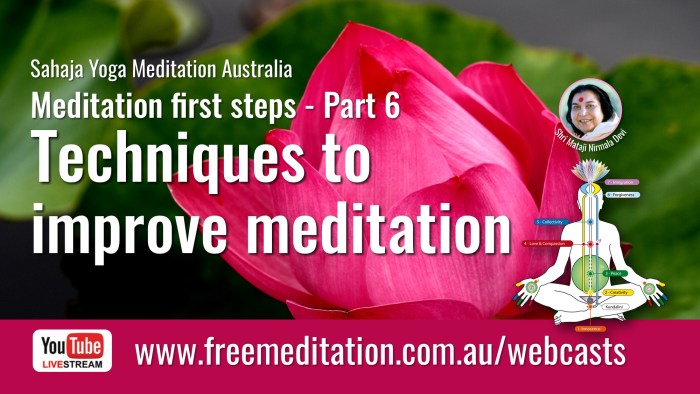10 Steps to Cultivate a Meditation Habit: Mastering the Art of Mindfulness takes you on a journey to explore the transformative power of meditation, providing insights and practical tips to help you establish a consistent practice.
Discover the keys to creating a fulfilling meditation routine and overcoming challenges along the way as you unlock the potential for growth and self-discovery.
Introduction to Meditation Habit

A meditation habit refers to the practice of setting aside time regularly to engage in meditation techniques for the purpose of enhancing mental, emotional, and physical well-being. It involves making meditation a consistent part of one’s daily routine.
Cultivating a regular meditation practice offers numerous benefits. Meditation has been scientifically proven to reduce stress, anxiety, and depression. It can improve focus, concentration, and overall cognitive function. Additionally, meditation promotes emotional resilience, mindfulness, and a sense of inner peace.
Importance of Consistency
Consistency is crucial in building a meditation habit. By meditating regularly, individuals can experience the cumulative benefits of the practice. Just like physical exercise, the more consistently one practices meditation, the more profound and lasting the effects will be on their overall well-being.
Understanding Meditation Techniques
When starting a meditation practice, it is essential to explore different techniques to find what works best for you. Here are some meditation techniques suitable for beginners:
Mindfulness Meditation
Mindfulness meditation involves focusing on the present moment without judgment. Here is the process of mindfulness meditation:
- Find a quiet and comfortable place to sit or lie down.
- Close your eyes and focus on your breath, bringing your attention to the sensation of breathing in and out.
- Notice when your mind starts to wander and gently bring it back to your breath without judgment.
- Continue this practice for a few minutes to start and gradually increase the duration as you become more comfortable.
Visualization Meditation
Visualization meditation involves creating a mental image or scenario to focus on. Here is how visualization meditation works:
- Choose a peaceful and calming image or scenario to visualize, such as a serene beach or a lush forest.
- Close your eyes and imagine yourself in that place, engaging all your senses to make the visualization more vivid.
- Focus on the details of the image, allowing yourself to feel relaxed and at peace.
- Stay in this visualization for a few minutes, letting go of any distractions or stress.
Setting Realistic Goals: 10 Steps To Cultivate A Meditation Habit

Setting realistic goals is crucial when establishing a meditation habit as it helps maintain motivation and progress. By setting achievable targets, individuals can track their growth and stay committed to their practice. Here are some tips on how to set realistic meditation goals:
Tips for Setting Realistic Meditation Goals
- Start small: Begin with short meditation sessions, such as 5-10 minutes, and gradually increase the duration as you become more comfortable.
- Be specific: Define clear goals for your meditation practice, whether it’s reducing stress, improving focus, or enhancing overall well-being.
- Track your progress: Keep a meditation journal to record your sessions, insights, and any changes you notice in your mental state over time.
- Consider your schedule: Choose a consistent time of day to meditate that fits into your routine to ensure regular practice.
Examples of Short-term and Long-term Meditation Goals, 10 Steps to Cultivate a Meditation Habit
- Short-term Goal: Meditate for 10 minutes every day for one week to establish a consistent practice.
- Long-term Goal: Reach a state of deep relaxation and mental clarity during a 30-minute meditation session by the end of the month.
Creating a Meditation Space
Creating a dedicated meditation space is crucial for establishing a consistent meditation practice. This space serves as a sanctuary where you can disconnect from distractions and focus on your inner peace. By having a designated area for meditation, you signal to your mind and body that it is time to unwind and center yourself.
Setting up a Peaceful and Comfortable Meditation Area
- Choose a quiet and clutter-free area: Select a spot in your home that is free from noise and distractions. Clear the space of any clutter to create a sense of calm and tranquility.
- Add comfortable seating: Whether it’s a cushion, chair, or meditation bench, ensure that your seating is comfortable and supportive. This will help you maintain proper posture during meditation.
- Incorporate calming elements: Consider adding elements like plants, soft lighting, or soothing colors to create a serene atmosphere. These elements can help relax your mind and enhance your meditation experience.
- Personalize your space: Make your meditation area reflect your personal taste and style. Adding meaningful decorations or items that bring you joy can make the space more inviting and conducive to meditation.
Role of Ambiance and Decor in Enhancing the Meditation Experience
- Lighting: Soft, natural light or dimmed lighting can create a relaxing ambiance for meditation. Avoid harsh overhead lights that may be too bright or distracting.
- Aromatherapy: Using essential oils or candles with calming scents like lavender or sandalwood can help set the mood for meditation and promote relaxation.
- Soundscape: Playing gentle music, nature sounds, or white noise can drown out external distractions and create a peaceful auditory backdrop for meditation.
- Sacred objects: Incorporating meaningful objects like crystals, statues, or symbols that hold spiritual significance for you can deepen your connection to your practice.
Establishing a Routine
Establishing a routine is crucial for maintaining a consistent meditation practice. By incorporating meditation into your daily schedule, you can reap the full benefits of this mindfulness practice.
Incorporating Meditation into Daily Routines
One effective way to incorporate meditation into your daily routine is to choose a specific time each day for your practice. This could be in the morning before starting your day, during a lunch break, or in the evening before bed. By setting aside dedicated time for meditation, you are more likely to stick to your practice.
- Create reminders: Set alarms or notifications on your phone or calendar to remind you to meditate at your chosen time.
- Integrate meditation with existing habits: Pair your meditation practice with another daily habit, such as brushing your teeth or making a cup of tea.
- Start small: Begin with just a few minutes of meditation each day and gradually increase the duration as it becomes a habit.
Best Times of Day for Meditation Practice
The best times of day for meditation practice can vary depending on individual preferences and schedules. However, many practitioners find that early mornings and evenings are ideal for meditation due to the peaceful and quiet atmosphere during these times.
Early morning meditation can help set a positive tone for the day, while evening meditation can help you unwind and relax before bedtime.
Tips for Overcoming Obstacles
Despite your best intentions, obstacles may arise that disrupt your meditation routine. Here are some tips to help you overcome these challenges:
- Identify barriers: Recognize what is preventing you from meditating regularly, whether it’s lack of time, distractions, or discomfort.
- Adapt your practice: Be flexible with your meditation schedule and find alternative times or locations to practice when your usual routine is disrupted.
- Stay committed: Remind yourself of the benefits of meditation and the positive impact it has on your well-being to stay motivated and committed to your practice.
Overcoming Challenges

When trying to establish a meditation habit, individuals may encounter various challenges that can hinder their progress. These challenges can include distractions during meditation sessions, resistance to practice, and lack of motivation. Overcoming these obstacles is essential to cultivate a consistent meditation routine.
Identifying Common Challenges
- Distractions: Common distractions during meditation sessions can include noises, physical discomfort, wandering thoughts, and external interruptions.
- Resistance and Lack of Motivation: Some individuals may find it challenging to commit to a regular meditation practice due to resistance towards sitting still or a lack of motivation to prioritize meditation in their daily routine.
Strategies to Overcome Distractions
- Create a Dedicated Space: Establishing a quiet and peaceful meditation space can help minimize external distractions and create a conducive environment for practice.
- Focus on Breath: Using focused breathing techniques can help redirect attention back to the present moment and reduce the impact of distractions.
- Practice Mindfulness: Cultivating mindfulness can enhance awareness of distractions without judgment, allowing individuals to acknowledge and let go of intrusive thoughts during meditation.
Dealing with Resistance and Lack of Motivation
- Start Small: Begin with short meditation sessions to gradually build consistency and overcome resistance towards longer practice durations.
- Set Realistic Goals: Establish achievable meditation goals and track progress to stay motivated and committed to the practice.
- Find Inspiration: Engage in guided meditations, join a meditation group, or seek inspiration from meditation teachers to stay motivated and connected to the practice.
Tracking Progress

Monitoring your progress in meditation practice can be a valuable tool in helping you stay motivated and focused on your goals. By tracking your meditation habits, you can identify patterns, measure improvements, and make adjustments to your practice as needed.
Benefits of Tracking Progress
- Provides a sense of accomplishment and motivation
- Helps identify areas for improvement
- Allows you to track consistency and frequency of practice
- Offers insights into the effectiveness of different techniques
Tools and Methods for Monitoring Meditation Habits
There are various tools and methods you can use to track your meditation progress:
- Use a meditation app or online tracker to log your practice sessions
- Keep a simple journal or calendar to mark the days you meditate
- Set reminders or alarms to help you maintain a consistent practice schedule
- Track your mood, energy levels, and overall well-being before and after meditation sessions
Keeping a Meditation Journal for Self-awareness and Growth
Maintaining a meditation journal can deepen your self-awareness and enhance personal growth in the following ways:
- Reflect on your thoughts, emotions, and experiences during meditation
- Track any insights or breakthroughs that arise during your practice
- Identify recurring patterns or obstacles in your meditation journey
- Set personal goals and intentions for your practice and monitor your progress
Finding Community Support

Connecting with others who share a meditation practice can significantly enhance your journey towards establishing a regular habit. By engaging with a community, you can gain support, motivation, and valuable insights that can deepen your meditation experience.
Ways to Find Local or Online Meditation Groups
- Search online directories or social media platforms for local meditation groups in your area.
- Attend meditation workshops, retreats, or classes held in community centers, yoga studios, or spiritual centers.
- Join online meditation forums, virtual meditation sessions, or group meditation apps to connect with like-minded individuals.
Benefits of Group Meditation Sessions and Accountability Partners
- Enhanced motivation and commitment: Being part of a group can inspire you to stay consistent with your practice.
- Shared experiences: Group sessions allow you to learn from others, share insights, and feel a sense of belonging.
- Accountability: Having a meditation buddy or group can hold you accountable for your practice, encouraging you to stay on track.
Incorporating Mindfulness in Daily Life
Mindfulness can be a powerful tool when integrated into daily life beyond meditation sessions. By practicing mindfulness throughout the day, individuals can enhance their overall well-being, reduce stress levels, and improve their mental clarity.
Examples of Integrating Mindfulness in Everyday Activities
- While eating: Pay attention to the flavors, textures, and sensations of each bite. Slow down and savor the experience.
- During daily chores: Focus on the present moment while washing dishes, folding laundry, or cleaning. Notice the sights, sounds, and feelings associated with each task.
- When commuting: Use your senses to tune into your surroundings during your commute. Listen to the sounds outside, feel the movement of the vehicle, and observe the passing scenery.
Impact of Mindfulness on Mental Well-being and Stress Management
Mindfulness has been shown to reduce rumination, improve focus and cognitive flexibility, and enhance emotional regulation. By incorporating mindfulness into daily life, individuals can better cope with stress, anxiety, and other mental health challenges.
Celebrating Milestones
Celebrating milestones in your meditation practice is essential to acknowledge your progress, stay motivated, and reinforce your commitment to the habit. It allows you to reflect on how far you’ve come and provides a sense of achievement that can boost your confidence and dedication.
Significance of Acknowledging Milestones
- Recognizing milestones helps you track your progress and see the positive impact of your meditation practice on your overall well-being.
- Celebrating achievements can create a sense of accomplishment and satisfaction, encouraging you to continue with your meditation habit.
- Reflecting on milestones allows you to identify areas of improvement and set new goals to further enhance your meditation practice.
Ideas for Rewarding Yourself
- Give yourself small treats or rewards after completing a certain number of consecutive meditation sessions, such as enjoying a piece of your favorite dessert or watching a movie.
- Reward yourself with self-care activities like a relaxing bath, a nature walk, or a massage to show appreciation for your dedication to meditation.
- Consider buying yourself a meaningful gift or item that can serve as a reminder of your progress and commitment to your meditation practice.
Reflecting on Progress and Setting New Goals
- Journal about your meditation journey, documenting your experiences, insights, and breakthroughs to reflect on how far you’ve come and what you’ve learned.
- Set aside time to review your meditation goals, assess your current practice, and identify areas where you can challenge yourself further or explore new techniques.
- Consult with a meditation teacher or mentor to gain valuable feedback on your progress, receive guidance on setting realistic goals, and refine your meditation practice for continuous growth.
Last Point
Embark on a path of self-improvement and inner peace with the guidance of 10 Steps to Cultivate a Meditation Habit: Mastering the Art of Mindfulness. Celebrate your progress, set new goals, and embrace a lifestyle enriched with mindfulness and well-being.